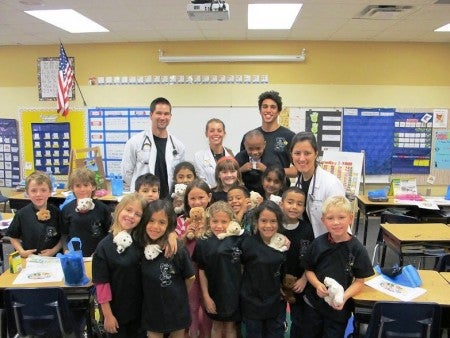The College of Medicine’s M-2 Student Council sponsored a Teddy Bear Clinic March 2 at the elementary school in Lake Nona to teach first-graders about anatomy, safety, hygiene, nutrition, and exercise.
About 35 medical students split into teams, one for each of the school’s nine first-grade classrooms. They passed out about 160 blue goodie bags – each holding a teddy bear, T-shirt, bottle of hand sanitizer, and an adhesive bandage. Students quickly slipped into the black College of Medicine T-shirts bearing a teddy bear logo and proclaiming “Teddy Bear Clinic.”
M-2 student Michelle Lipton – who organized the event – said the elementary school was the perfect outlet for students to share their medical knowledge. “The best way to shape healthy habits is to start at a young age,” she said. Other event coordinators were with M-1 Amy Bino, who designed the T-shirts, and M-2s Lyndsey Burton and Mikaela Devaux
In Mrs. Lesia Griswold’s class, first-graders buzzed as they put crayons to paper and concentrated on drawing a picture of what medicine meant to them.
They drew sick people in beds, a tailless dolphin, and a helicopter. “Did you know they use helicopters in medicine sometimes?” a COM student asked.
Next, students were handed a drawing of a teddy bear and asked to find major body parts. They pointed to their hearts, then pointed to where the organ would be on the drawing. “What does the heart do?” asked Michelle, joined by M-2 Mihail Stojanovski, and M-1 students Ron Mercer and Phil Romanski.
“It pumps blood!” the students shouted. “It keeps you alive.”
“What does the stomach do?” she asked.
“It growls!” a grinning first-grader said.
To stress the importance of exercise, the med students cranked up a song that urged everyone to “dance like an animal – boogie-woogie all day long.” Suddenly the class was filled with monkeys jumping, elephants swinging their trunks, and hippos shaking.
The COM students reviewed how to call 9-1-1 for help, give the universal signal for choking – hands clutching your throat, and properly wash your hands. The Teddy Bear Clinic ended with a talk about healthy eating habits and the food pyramid. One student, unsure about raspberries, said he preferred ice cream.
M-2 Lauren Richter said the first-graders’ enthusiasm was infectious. “One of the moments that stood out to me was when we were talking about emergencies: One of the kids started doing CPR on his bear!” she said. “It’s opportunities like the Teddy Bear Clinic that really motivate you to keep working hard to reach your ultimate goal of practicing medicine.”
